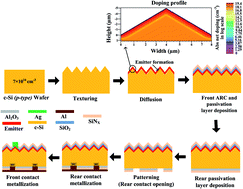Design and parametric optimization of ion-implanted PERC solar cells to achieve 22.8% efficiency: a process and device simulation study
Abstract
Silicon-based photovoltaic (PV) technology is considered the most favourable approach, and has received great consideration worldwide, to possibly meet the ever-growing need for energy. Silicon-passivated emitter and rear cells (PERCs) are promising contenders for mass production in the PV industry. However, PERC devices suffer from losses that limit the device performance. Recombination of minority carriers and absorption losses in PV devices are major limiting factors that restrain the achievable values of power conversion efficiency (PCE). In an attempt to circumvent these losses and enhance PCE, regular upright pyramid surface textured ion-implanted PERC solar devices are designed and simulated using industry-standard process and device simulators. The devices under consideration are constructed using the Athena process simulator using deposit, ion implantation, etch, and diffusion statements. The collective impact of the process parameters, namely, ion implantation dose (1 × 1014 cm−2 to 5 × 1015 cm−2) and energy (10 keV to 30 keV) at a constant diffusion temperature and time of 950 °C and 30 min on the total saturation current density (jo), series resistance (Rs) and PV parameters have been investigated to optimize the emitter region performance. Furthermore, parametric optimization of the bulk thickness (Tbulk) of the boron-doped crystalline silicon (c-Si) wafer, carrier lifetime (τcarrier) and length of a half pyramid (LoHpyramid) has been carried out to improve the PCE. The optimized PERC device with a dose of 7.5 × 1015 cm−2, energy of 30 keV, Tbulk of 150 μm, τcarrier of 2 ms and LoHpyramid of 4 μm yielded a short-circuit current density (JSC) of 40.8 mA cm−2, open-circuit voltage (VOC) of 686 mV, fill factor (FF) of 81.54% and PCE of 22.8% along with a jo of 101 fA cm−2 and Rs of 578 mΩ cm2. A detailed comparison of the simulated efficiency with published experimental work has been made, followed by loss analysis relative to the Auger limit efficiency of 29.4%. The reported device may open a window for further expansion of the PERC solar cell for higher efficiencies.



 Please wait while we load your content...
Please wait while we load your content...